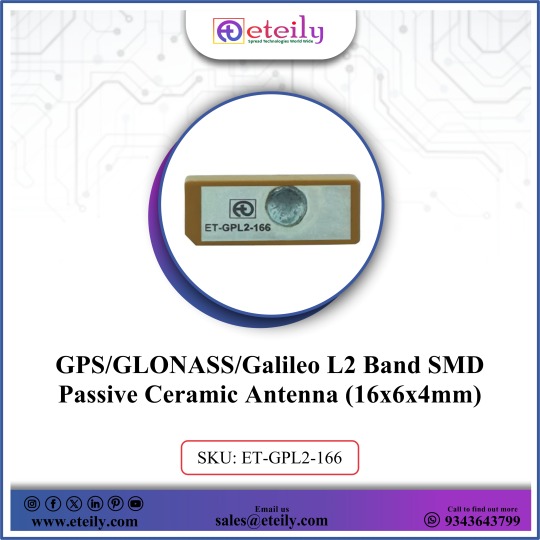#Eteily RF components
Explore tagged Tumblr posts
Text
Antennas for the Internet of Things (IoT): Design Considerations
The Internet of Things (IoT) has transformed device communication, allowing smart homes, linked automobiles, industrial automation, and more. At the heart of any IoT device is a critical component: the antenna. Whether it's a wearable fitness tracker or a distant environmental sensor, the antenna dictates how well wireless communication works.

Designing antennas for IoT applications presents unique problems owing to physical limits, varying surroundings, and the necessity for energy efficiency. In this post, we'll look at the most important factors to consider while designing antennas for Internet of Things devices.
1. Compact Size and Form Factor
IoT devices are often compact, with little room for components.
Antennas must be miniaturized while maintaining performance.
Chip antennas, PCB trace antennas, and meandering dipoles are popular ways to conserve space.
Designers must carefully regulate ground plane size and antenna location to minimize performance degradation.
2. Frequency Band Requirements
Depending on the application, IoT devices use a variety of frequencies:
Long-range, low-power applications like as LoRa and Sigfox operate at sub-GHz frequencies (433 MHz, 868 MHz, and 915 MHz, respectively).
2.4 GHz and 5 GHz frequencies are often used for Wi-Fi and Bluetooth communication.
Cellular IoT (NB-IoT, LTE-M) operates on a variety of approved cellular bands.
The antenna must be constructed or adjusted to perform optimally within the target application's frequency spectrum.
3. Power Efficiency
Many IoT gadgets rely on batteries and have extended lifespans.
Antennas must be very power-efficient in order to provide minimal signal loss and maximum range while using little power.
High radiation efficiency and low VSWR are critical design parameters.
Energy-efficient antennas extend device battery life, which is crucial in distant and inaccessible installations.
4. Environmental Conditions
IoT devices are frequently utilised in a variety of difficult conditions, including inside, outdoors, underground, and even within the human body (for medical equipment).
For outdoor or industrial applications, antennas must be durable and weather-resistant.
The materials utilised must tolerate temperature, moisture, and UV exposure.
Biocompatibility and flexibility are critical features of wearable or implanted devices.
5. Integration and Interference Management
IoT systems frequently incorporate numerous radios such as Wi-Fi, Bluetooth, GPS, and Zigbee.
Antennas should be built to minimise mutual interference.
Antenna isolation and EMC compliance are critical for maintaining clean signal transmission and reception.
The use of multi-band or tunable antennas reduces the amount of components required in a compact device.
6. Cost and Mass Production Considerations
Scalability is crucial for IoT manufacturers.
Antennas should be affordable for high-volume manufacture.
Antennas that are incorporated onto PCBs minimise the number of parts required for assembly.
Designs should be easy to copy and function consistently across batches.
Conclusion
Designing antennas for Internet of Things applications is a combination of science and art. Engineers must strike a balance between performance, size, efficiency, and durability when designing antennas that keep devices linked consistently across a wide range of applications. With the expanding use of IoT in enterprises, communities, and households, antenna innovation is vital to enabling a truly connected world.
Contact Us
Eteily Technologies India Pvt. Ltd.
📍 B28 Vidhya Nagar, Near SBI Bank Bhopal - 462026, Madhya Pradesh 📧 Email: [email protected] 📞 Phone: +91-9993979758 🌐 Website: https://eteily.com
#IoT antenna design#smart device connectivity#low-power antenna#PCB antenna#chip antenna#wireless communication#LPWAN#NB-IoT#antenna integration#Eteily RF components
0 notes
Text

The GPS PCB Active Patch Antenna is specifically engineered for L1 band applications at 1575.42 MHz. It incorporates a high-performance ceramic patch mounted on a PCB, complete with an integrated low-noise amplifier (LNA) to enhance signal strength. The antenna is supplied with a 1.13mm cable (10cm) and a UFL connector, facilitating seamless integration into compact GPS devices. Its dimensions are 15×15×4mm.
#rf antenna#rf antenna manufacture#telecom#rf antenna india#eteily technology manufactures#manufacturing
0 notes
Text

Eteily Technologies India Pvt. Ltd.
5G 3dBi Rubber Duck Antenna With SMA Male Movable Connector
SKU: ET-5G3R-SMMO
For More Info -
9343643799
#rubber duck antenna#best rubber duck antenna#rf antenna#5g antenna#rf antenna in telecom#rf antenna manufacturers
0 notes
Text
youtube
#SMB Connectors#eteily#tech#technologies#RF connector#Coaxial Connectors#SMB Connector Series#SMB Plug & Jack#plug connector#Crimp SMB#Electromechanical Components#SMB Cable#SMB RF Coaxial Connector#high quality SMB Plug#RF components#SMB Hermetic Connector#SMC and CMS connectors#Youtube
0 notes
Link
LORA ANTENNAS
http://www.eteily.com/87-lora-antennas
#RF Antenna #RF Connector #RF Cable Assembly #RF Cable #RF Adaptor #PCB Components #Other Components #Solar Components
0 notes
Text
Challenges in Antenna Design for High-Frequency Applications
As sectors push the limits of speed and bandwidth—think 5G mmWave, satellite communications, radar, and aerospace—demand for high-frequency antennas (usually above 3 GHz) is fast increasing. However, creating antennas for these frequencies is not straightforward. In reality, it presents a distinct set of technical issues.
In this article, we'll look at the major issues that antenna designers encounter in high-frequency applications—and how businesses like Eteily Technologies are addressing them.

1. Signal Loss and Material Limitations:
At high frequencies, even tiny losses can cause significant performance decreases.
The dielectric loss in substrates (such as FR4) becomes increasingly substantial.
Conductive losses rise with the skin effect, which occurs when current runs exclusively on the surface of a conductor.
✅ Solution: Use low-loss materials such as PTFE, Rogers, or ceramic-based substrates for improved performance.
2. Miniaturization vs Performance:
Higher frequencies result in shorter wavelengths, which equates to smaller antennas.
However, lowering antenna size can:
Lower gain.
Decrease bandwidth.
Increase the sensitivity to fabrication flaws.
✅ Solution: Precision engineering, sophisticated simulation, and multi-layer PCB integration combine small size with high performance.
3. Electromagnetic Interference (EMI):
At higher frequencies, antennas are more susceptible to interference from neighboring components and systems.
✅ Solution: Use EMI shielding, provide correct antenna separation, and regulate the device's internal RF structure.
4. Manufacturing Tolerances:
At high frequencies, even little differences in form, spacing, or material might cause the antenna to detune.
✅ Solution: Maintain consistency across batches with tight tolerance manufacturing and consistent quality control.
5. Complex Simulation and Testing:
Simulation of high-frequency performance is more complicated and requires specialized techniques such as:
HFSS (High Frequency Structure Simulator)
CST Microwave Studio
Network analyzers up to 50 GHz+.
✅ Solution: Eteily combines powerful EM simulation with real-world prototyping to achieve accuracy and speed.
6. Thermal Management:
High-frequency systems, particularly those used in 5G base stations or radar, can create a substantial amount of heat.
✅ Solution: Use thermal vias, heatsinks, and low-power-loss designs to regulate heat while maintaining performance.
Eteily's Expertise in High-Frequency RF Antennas
We create high-performance antennas and modules up to 40+ GHz, suited for:
5G mmWave
Automotive radar
Aerospace communication
High-speed data connections
Industrial IoT
From bespoke PCB patch antennas to phased array modules, our staff guarantees that your product remains quick, precise, and dependable.
📣 Contact Us
Eteily Technologies India Pvt. Ltd.
📍 B28 Vidhya Nagar, Near SBI Bank Bhopal - 462026, Madhya Pradesh 📧 Email: [email protected] 📞 Phone: +91-9993979758 🌐 Website: https://eteily.com
#HighFrequencyAntenna#AntennaDesign#5GAntenna#RFChallenges#mmWaveTech#EteilySolutions#WirelessEngineering#AdvancedAntennaDesign#RFInnovation
0 notes
Text
RF Antennas in Wearable Technology: Challenges and Solutions.
The emergence of wearable technology—from smartwatches and fitness bands to health monitors and augmented reality glasses—has altered how we engage with technology and monitor our health and fitness. At the heart of these smart gadgets is a vital component: the RF antenna. Despite their tiny size, these antennas must enable dependable wireless connectivity for Bluetooth, Wi-Fi, GPS, LTE, and other applications.

However, developing RF antennas for wearables is significantly more difficult than for standard electronics. The tiny size, bodily closeness, and diverse application settings create unique problems that necessitate innovative technical solutions. In this post, we will look at the primary obstacles of incorporating RF antennas into wearables and how they are being solved.
Key Issues in RF Antenna Design for Wearables
1. Limited Space and Form Factors
Wearable gadgets require elegant, compact designs that frequently leave little room for internal components.
Antennas must be miniaturized while maintaining performance.
Smaller antennas often have lower gain and efficiency.
Flexible or conformal antennas are frequently required to fit onto curved surfaces, such as bracelets or spectacles.
2. Human Body Interference
The human body absorbs and reflects radiofrequency waves, which has a substantial impact on antenna performance.
Proximity to skin and tissues can detune the antenna, resulting in signal loss or poor match.
When wearing the gadget, signal attenuation rises in comparison to open-air operation.
Body movement and posture might result in dynamic detuning.
3. Multi-Band and Multi-Protocol Support
Most wearables must support various wireless technologies:
Bluetooth / BLE provides short-range connection.
Data synchronization and upgrades require Wi-Fi or LTE connectivity.
GPS/GNSS for tracking and navigation.
Designing a single antenna or a compact antenna system that covers many bands without interference is a difficult problem, particularly in tiny spaces.
4. Power Efficiency
Wearables frequently run on tiny batteries and must preserve power for prolonged use.
Antennas must have a high radiation efficiency to lower transmission power requirements.
Poor antenna efficiency causes increased power consumption and shorter battery life.
5. Mechanical and Environmental Durability
Wearables are employed in a variety of environments, including perspiration, rain, temperature changes, and regular wear and tear.
Antennas must be flexible, strong, and resistant to moisture and mechanical stress.
The materials utilized must be biocompatible and suitable for contact with the skin.
Solutions and Innovations for Wearable Antenna Design
1. Flexible and Textile Antennas
Antennas made using conductive fabrics or inks can be embedded into clothing or wristbands.
These are lightweight, stretchable, and comfortable for the user.
2. On-Body Simulation and Tuning
Advanced simulation techniques model how the body affects RF performance.
Phantoms or body models are used to adjust antennas so that they match real-world applications.
3. Ground-Independent Antennas
Designed for wearables with small PCBs that do not require a big ground plane.
Use techniques such as folded elements and balanced feed systems.
4. Antenna Diversity & Switching
Devices may include numerous antennas or switchable parts to maintain connectivity while the user moves or changes orientation.
5. Integrated Antenna Modules
RF front ends and antennas can be bundled into tiny modules, making design easier and enhancing performance uniformity.
Conclusion
RF antenna design for wearable electronics is a fast changing topic that needs a thorough grasp of RF concepts, human anatomy, materials science, and mechanical engineering. Overcoming the particular problems of body-worn electronics helps wearables stay connected, efficient, and pleasant.
Eteily Technologies specialises in unique RF antenna systems that drive next-generation wearable technology. Whether you're creating fitness trackers, smart eyewear, or health monitors, we have the experience to bring your idea to life via dependable wireless performance.
Contact Us
Eteily Technologies India Pvt. Ltd.
📍 B28 Vidhya Nagar, Near SBI Bank Bhopal - 462026, Madhya Pradesh 📧 Email: [email protected] 📞 Phone: +91-9993979758 🌐 Website: https://eteily.com
#wearable antennas#RF in wearable technology#Bluetooth antenna#GPS in wearables#flexible antenna#body-worn devices#antenna tuning#low-power RF#5g antenna#rf antenna#iot lora antenna
0 notes
Text

The GPS GLONASS Galileo L1 Band SMD Passive Ceramic Antenna (8x8x4mm) is a small and adaptable antenna intended for operation within GPS, GLONASS, and Galileo satellite systems. It functions mainly on the L1 band, the frequency most frequently utilized for civilian GPS purposes. This antenna is commonly found in devices that necessitate accurate positioning and navigation, including smartphones, drones, automotive systems, and wearable GPS technology.
0 notes
Text
The GPS GLONASS Galileo L1 + L2 Band SMD Passive Ceramic Antenna, measuring 10x10x4mm, is a compact and efficient antenna tailored for multi-constellation GNSS applications. It is compatible with GPS, GLONASS, and Galileo systems operating on both L1 and L2 bands. Its diminutive dimensions (10x10x4mm) render it particularly suitable for devices with limited space that demand accurate positioning.
#eteily technology manufactures#eteily india#rf antenna#rf antenna manufacture#rf antenna price#rf antenna india#manufacturing#entrepreneur#youtube#telecom
0 notes
Text

The GPS GLONASS Galileo L2 Band SMD Passive Ceramic Antenna (16x6x4mm) provides high-precision positioning across multiple constellations. Engineered for compact applications, it is compatible with GPS, GLONASS, and Galileo signals within the L2 frequency band. Its compact dimensions guarantee versatility while ensuring dependable and precise satellite connectivity across a range of systems and devices.
#eteily india#rf antenna#rf antenna india#rf antenna price#rf antenna manufacture#manufacturing#eteily technology manufactures#telecom
0 notes
Text
The GPS GLONASS Galileo L2 Band SMD Passive Ceramic Antenna (16x6x4mm) provides high-precision positioning across multiple constellations. Engineered for compact applications, it is compatible with GPS, GLONASS, and Galileo signals within the L2 frequency band. Its compact dimensions guarantee versatility while ensuring dependable and precise satellite connectivity across a range of systems and devices.
#rf antenna#eteily technology manufactures#rf antenna manufacture#manufacturing#rf antenna india#rf antenna price#eteily india#gpsantenna
0 notes
Text
https://eteily.com/rf-components/1350-eteily-5g-products-mini-din-connector-low-pim-combiner-3-in-2-out-hybrid-coupler-88-470mhz-n-female-with-43-10-connectors.html
0 notes
Text
https://eteily.com/rf-components/1045-eteily-one-hole-rubber-feeder-cable-clamp-for-14-78-12-coaxial-cable.html
0 notes
Text
0 notes